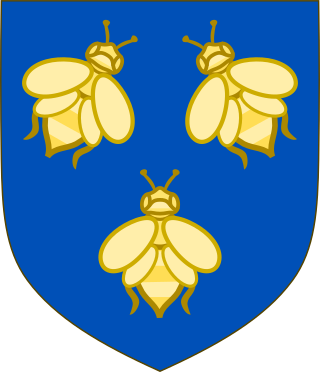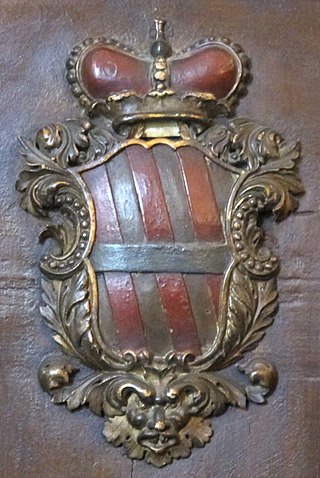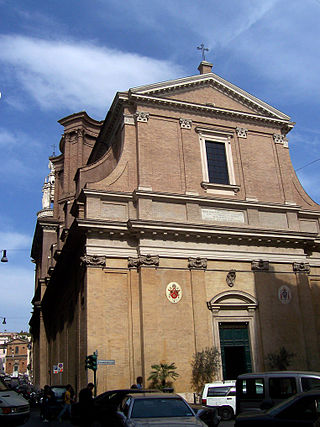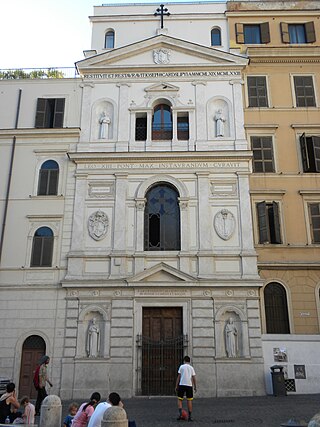
Pope Urban VIII, born Maffeo Vincenzo Barberini, was head of the Catholic Church and ruler of the Papal States from 6 August 1623 to his death in July 1644. As pope, he expanded the papal territory by force of arms and advantageous politicking, and was also a prominent patron of the arts and a reformer of Church missions.

Santa Maria sopra Minerva is one of the major churches of the Catholic Order of Preachers in Rome, Italy. The church's name derives from the fact that the first Christian church structure on the site was built directly over the ruins or foundations of a temple dedicated to the Egyptian goddess Isis, which had been erroneously ascribed to the Greco-Roman goddess Minerva.
Frosinone is a town and comune in Lazio, central Italy, the administrative seat of the province of Frosinone. It is located about 75 kilometres (47 mi) south-east of Rome close to the Rome-Naples A1 Motorway. The city is the main city of the Valle Latina, an Italian geographical and historical region that extends from south of Rome to Cassino. Until the nineteenth century it was a village with a rural vocation, while from the twentieth century it became an important industrial and commercial center. Traditionally considered a Volscian city, with the name of Frusna and then the Roman of Latium adiectum as Frùsino, over the course of its millenary history it has been subjected to multiple devastations and plunders caused by its geostrategic position; as a consequence of this, as well as due to the destruction due to seismic events, it retains only rare, albeit significant, traces of its past.

The House of Barberini are a family of the Italian nobility that rose to prominence in 17th century Rome. Their influence peaked with the election of Cardinal Maffeo Barberini to the papal throne in 1623, as Pope Urban VIII. Their urban palace, the Palazzo Barberini, completed in 1633 by Bernini, today houses Italy's Galleria Nazionale d'Arte Antica.

There are more than 900 churches in Rome. Most, but not all, of these are Catholic.

The House of Corsini is the name of an old and influential Florentine princely family.

The National Roman Museum is a museum, with several branches in separate buildings throughout the city of Rome, Italy. It shows exhibits from the pre- and early history of Rome, with a focus on archaeological findings from the period of Ancient Rome.

Sant'Andrea delle Fratte is a 17th-century basilica church in Rome, Italy, dedicated to St. Andrew. The Cardinal Priest of the Titulus S. Andreae Apostoli de Hortis is Ennio Antonelli.

The Minor Basilica of St. Mary in Domnica alla Navicella, or simply Santa Maria in Domnica or Santa Maria alla Navicella, is a Roman Catholic basilica in Rome, Italy, dedicated to the Blessed Virgin Mary and active in local charity according to its long tradition. It is one of the best examples of the so-called "Carolingian renaissance" in Rome. It has been the titular church of Cardinal Marcello Semeraro since 28 November 2020.

The Basilica of St. Bartholomew on the Island is a titular minor basilica, located in Rome, Italy. It was founded in 998 by Otto III, Holy Roman Emperor and contains the putative relics of St. Bartholomew the Apostle. It is located on Tiber Island, on the site of the former temple of Aesculapius, which had cleansed the island of its former ill-repute among the Romans and established its reputation as a hospital, continued under Christian auspices today.

Sant'Agata dei Goti is a church in Rome, Italy, dedicated to the martyr Agatha of Sicily. It is the diaconia assigned to Cardinal Raymond Leo Burke, patron of the Sovereign Military Order of Malta.

San Nicola in Carcere is a titular church in Rome near the Forum Boarium in rione Sant'Angelo. It is one of the traditional stational churches of Lent.

San Teodoro is a 6th-century church in Rome. It was dedicated to Theodore of Amasea and given to the Eastern Orthodox community of Rome by Pope John Paul II in 2004. It is located on an ancient road between the Roman Forum and Forum Boarium, along the north-western foot of the Palatine Hill.

Appia Annia Regilla, full name Appia Annia Regilla Atilia Caucidia Tertulla, was a wealthy, aristocratic and influential Roman woman, who was a distant relative of several Roman emperors and empresses. She was the wife of the prominent Greek Herodes Atticus.

The Caffarella Park is a large park in Rome, Italy, protected from development. It is part of the Parco Regionale Appia Antica. The park is contained in the Caffarella Valley and is bordered on its northern side by the Via Latina and on its southern by the Appian Way. It stretches from the main Rome-Pisa railroad tracks near the Aurelian Wall at its western edge to the Via dell'Almone to the east. It contains several sites of archaeological interest, as well as a working farm, and has considerable ecological value, with 78 species of birds and fauna. The Catacombs of Rome and Colli Albani are nearby.

Santi Sergio e Bacco is a Catholic church of the Byzantine Rite located on Piazza Madonna dei Monti in the rione of Monti in Rome, Italy. Saints Sergius and Bacchus are said to have been early fourth-century Roman military officers and Christian martyrs buried in Syria. In the 9th century the church was known as Sergius and Bacchus in Callinico, in the Middle Ages as Sergius and Bacchus de Suburra, and from the 18th century forward has been known also as the church of Madonna del Pascolo. Since 1970 it has been a national church of the Ukrainian Greek Catholic Church in Rome and was known officially as the "Parish of Ukrainian Catholics of Madonna del Pascolo and Saints Sergius and Bacchus." Since 2019 the church serves as a cathedral for the Ukrainian Catholic Apostolic Exarchate of Italy.
The Pontificio Collegio Urbano de Propaganda Fide was established in 1627 for the purpose of training missionaries to spread Catholicism around the world.

Capo di Bove is an archaeological site on the Appian Way on the outskirts of Rome, Italy. It contains the thermal baths of a vast property owned in the 2nd century AD by Herodes Atticus and his wife Annia Regilla.

The basilica of Santi Cosma e Damiano is a titular church in Rome, Italy. The lower portion of the building is accessible through the Roman Forum and incorporates original Roman buildings, but the entrance to the upper level is outside the Forum. The circular building located at the entrance of the Forum, which now houses a small archeological exhibit, was built in the early 4th century as a Roman temple. It is thought to have been dedicated to Valerius Romulus, deified son of the emperor Maxentius. The main building was perhaps the library of an imperial forum.

The Appian Way Regional Park is the second-largest urban park of Europe, after Losiny Ostrov National Park in Moscow. It is a protected area of around 4580 hectares, established by the Italian region of Latium. It falls primarily within the territory of Rome but parts also extend into the neighbouring towns of Ciampino and Marino.




















